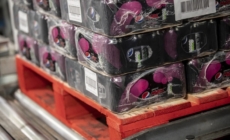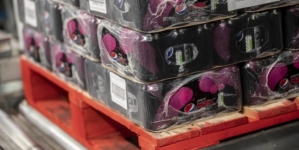-
Delivery management platform, Scurri topped over €12 billion in Gross Merchandise Value (GMV) in the total value of shipments processed in 2023 - 1 day ago
-
Britvic reaffirms partnership with LPR - 1 day ago
-
Geo2 routes for the planet by transforming delivery - April 9, 2024
-
Kammac Supports Nimble’s Expansion into 500 Tesco Stores - April 5, 2024
-
Axiom Sustainability Software launches groundbreaking Social Value Calculator - April 4, 2024
-
Change to minimum wage and its impact on logistics - April 3, 2024
-
PARKSAFE GROUP TEAMS UP WITH QUECLINK WIRELESS SOLUTIONS IN FLEET TECHNOLOGY PARTNERSHIP - March 27, 2024
-
Facing shocking levels of violence at work – yet not paid enough to live on: 57% of UK retail staff say their wages barely cover basic expenses, despite many working more hours than ever - March 26, 2024
-
Bridgestone proving the worth of its Duravis Van tyre through academic study - March 25, 2024
-
Fleetmaxx Solutions announces Vanaways partnership - March 25, 2024
Warehouse KPI blog by Gwynne Richards
The Warehousing Education Research Council in the U.S. recently published their annual 2016 Distribution Centre survey on Key performance indicators.
This survey is sent to warehouse operators globally however there is a significant focus on the United States (88% of responses). There were 315 responses in total. The largest segments were Retail, manufacturing and third-party warehousing accounting for over 74% of the responses.
The survey participants were as follows:
- Just under 69% of the respondents operated their own warehouses
- The remainder either solely used 3PLs or a mix of owned and 3PL.
- 31% of the respondents had sales in excess of $1 billion
- 4% had sales of less than $100 million.
- 5% of the respondents pick cases as opposed to Part or full pallets.
The top 12 key performance indicators mostly used by companies were as follows:
Table 1 Top 12 Metrics – 2016
| Metric | 2016 rank | 2015 rank | 2014 rank |
| On-time Shipments – Customer
|
1 | 1 | 1 |
| Average Warehouse Capacity Used – Capacity | 2 | 6 | 8 |
| Order Picking Accuracy, Percent by Order – Quality | 3 | 5 | 5 |
| Dock-to-Stock Cycle Time, in Hours – Inbound | 4 | 3 | 4 |
| Internal Order Cycle Time, in Hours – Customer | 5 | 2 | 2 |
| Percent of Supplier Orders Received Damage Free – Inbound | 6 | 10 | 7 |
| Peak Warehouse Capacity Used – Capacity | 7 | 7 | 9 |
| Lines Picked and Shipped per Person Hour – Outbound | 8 | 11 | 6 |
| Total Order Cycle Time, in Hours – Customer | 9 | 4 | 3 |
| Order Fill Rate – Outbound
|
10 | – | – |
| Lines Received and Put Away per Hour – Inbound | 11 | 12 | 10 |
| On-time Ready to Ship – Outbound
|
12 | – | – |
The metrics were divided into five main categories – Inbound, outbound, customer, capacity and quality. There were also categories for finance and safety.
There is a mix of performance and productivity metrics. The performance metrics include both suppliers and the operation itself. On-time shipments has been the number one metric for the past three years with internal order processing time dropping from second to fifth.
Order pick accuracy rose to number three which outlines the importance of on time, in full delivery. Late and incomplete orders result in fewer customers.
Average and peak warehouse capacity are interesting metrics. Frazelle (2002) suggests that an ideal % occupancy rate is 86% as anything above this figure will lead to inefficiency and safety issues. However, the question lies in whether the warehouse is the correct size in the first place. In an age when warehouses are targeted with greater throughput and less inventory held, this measure can be miss-leading. Yes, it is good to utilise the warehouse space efficiently however it is surely better to reduce the overall stock-holding but retain the service level. This could well result in a much lower utilisation of the space over time yet retaining or even increasing service levels.
At peak, with 100% utilisation, this suggests that before a pallet can be put-away another pallet has to be removed. This can lead to very poor efficiency and situations where products end up blocking aisles and inbound areas.
A low dock to stock time is important as this enables products to be available for sale much quicker. It’s also good to see that suppliers are also included in the top 12 KPI.
There does seem to be some overlap with the measures and I would have preferred to see at least one safety metric in the top 12. Also many of the DCs and warehouses are continuing to focus on customers and processes rather than employee or financial metrics.
All the companies were asked to provide their own performance measures and this makes for interesting reading. The top performing 20% (Best in Class) together with the bottom 20% (Major opportunity) are shown together with the median results. Table 2 shows figures for the above metrics together with the Perfect order metric.
Table 2 Top 12 metrics and the perfect order results – 2016
| Metric | Major opportunity | Median | Best in Class |
| On-time Shipments – Customer
|
<95% | 93.8% | ≥99.8% |
| Average Warehouse Capacity Used – Capacity | <75% | 84.25% | 94.4% |
| Order Picking Accuracy, Percent by Order – Quality | <97% | 99.3% | 99.8% |
| Dock-to-Stock Cycle Time, in Hours – Inbound | >21.5 hours | 6 hours | <2 hours |
| Internal Order Cycle Time, in Hours – Customer | >26.6 hours | 11.4 hours | 3.1 hours |
| Percent of Supplier Orders received Damage Free – Inbound | <90.72% | 98% | ≥99.3% |
| Peak Warehouse Capacity Used – Capacity | <87.88% | 95% | ≥100% |
| Lines Picked and Shipped per Person Hour – Outbound | <12 per hour | 32 per hour | ≥65 per hour |
| Total Order Cycle Time, in Hours – Customer | >72 hours | 22.65 hours | <4 hours |
| Order Fill Rate – Outbound
|
92% | 98% | 99.69% |
| Lines Received and Put Away per Hour – Inbound | <7.56 per hour | 20 per hour | 44.9 per hour |
| On-time Ready to Ship – Outbound
|
<90% | 98.5% | ≥99.9% |
| Perfect order shipment – Customer
|
<83.2% | 97.7% | ≥99% |
The perfect order shipment relates to on time, in full, damage free with the correct paperwork. The results of each metric are multiplied together.
There are 50 specific measures included in the report, many of which can be included in a performance measures portfolio. The important thing is not to have too many as you will spend more time measuring than you will taking action on the major opportunities for improvement.
In order to access the full report companies need to join WERC.
References
Frazelle E H (2002) World-Class Warehousing and Material Handling McGraw Hill New York
DC Measures 2016 is published in WERCwatch published by WERC, 1100 Jorie Blvd., Suite 170, Oak Brook, IL 60523-4413. ©2016, Warehousing Education and Research Council.































